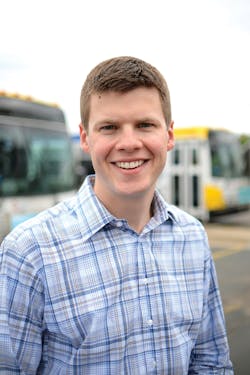Top 40 Under 40 2014: Charles Carlson
As Metro Transit’s senior manager of Transitway Development, Charles Carlson has been a leader of Metro Transit’s Bus Rapid Transit/Small Starts Project Office. The office is responsible for planning and implementing an ambitious arterial BRT system that will bring faster, more frequent service to the most-traveled transitways in the Twin Cities.
The office is also leading the development of the Metro Orange Line, which will bring BRT service to one of the busiest highways in Minnesota, and recently completed the first study of transit alternatives for a busy south Minneapolis corridor that will connect two light rail lines. Together, these projects represent more than $800 million in capital investments and will attract 25 million rides annually.
Carlson started in his current role in September 2012 after working as a facilities planner in Metro Transit’s Engineering & Facilities Department and as a planner for the Metropolitan Council, of which Metro Transit is an operating division.
In his current role, Carlson leads a growing office that now includes four full-time planners and engineers, providing key leadership that keeps projects on time and on budget. He also works closely with various Metro Transit departments, consultants, state and municipal partners and community stakeholders to build consensus and support for the BRT projects throughout the planning process.
Carlson has been an effective advocate for BRT projects, securing more than $100 million in competitive funds from regional, state and federal sources. His testimony to the state legislature in 2014 helped secure full funding for the $25 million A Line, which will be under construction in 2015. The A Line is the first of more than a dozen arterial BRT corridors where technology and facility improvements will speed travel times by 25 percent and new station areas will enhance the customer experience. The foundational study of arterial BRT lines led by the BRT/Small Starts office received an Innovation in Planning Award from the Minnesota chapter of the American Planning Association in 2013.
In coordination with the Minnesota Department of Transportation, Hennepin County and other partners, the Metro Orange Line will be under construction in 2016 and open in 2019, providing all-day, frequent transit service between downtown Minneapolis and its southern suburbs.
Carlson has been especially effective in his role because of his personal commitment to transit. In 2014, he sold his vehicle and made transit his primary mode of travel. Leading by example, staff at the BRT/Small Starts Project Office have become among the most dedicated transit users employed at Metro Transit. He has also led his planning staff into new territory by involving Metro Transit’s outreach and communications staff at every phase of project development. Planners have broken from the traditional open house model by meeting with stakeholders at local businesses and in non-traditional settings. E-mail newsletters and social media have been leveraged to share project details and solicit direct feedback from transit customers and stakeholders.
Carlson lives in south Minneapolis with his wife and two children. His interests include woodworking, home improvement, growing food and cycling.
“I am most motivated by seeing how my project managers develop working relationships with the public and with stakeholders. We use a fundamentally different model that focuses on community engagement. At the BRT Project Office, it doesn’t matter if you’re a manager or an engineer or an intern; we’re all in the business of authentic community engagement.”
“Ten years ago nobody was talking about BRT, and from my intern role to senior management today I’ve been continuously afforded opportunities to shape and define what that means for this region. We’ve evolved from finding ways to carve out dedicated lanes to a problem-solving focus of learning and solving the challenges by corridor. In some cases lanes are required, in others the main problem is slow fare payment.”
“In the next few decades, I think personal ownership of automobiles will reduce as the sharing economy grows and we see advances in both electric and autonomous vehicles. This will begin close to urban cores, and I think this has potentially profound impacts on how we will use transit. I believe it has greater implications on how we use land when so much space needn’t be dedicated to storing cars. Being part of that revolution is an opportunity for public transit.”
